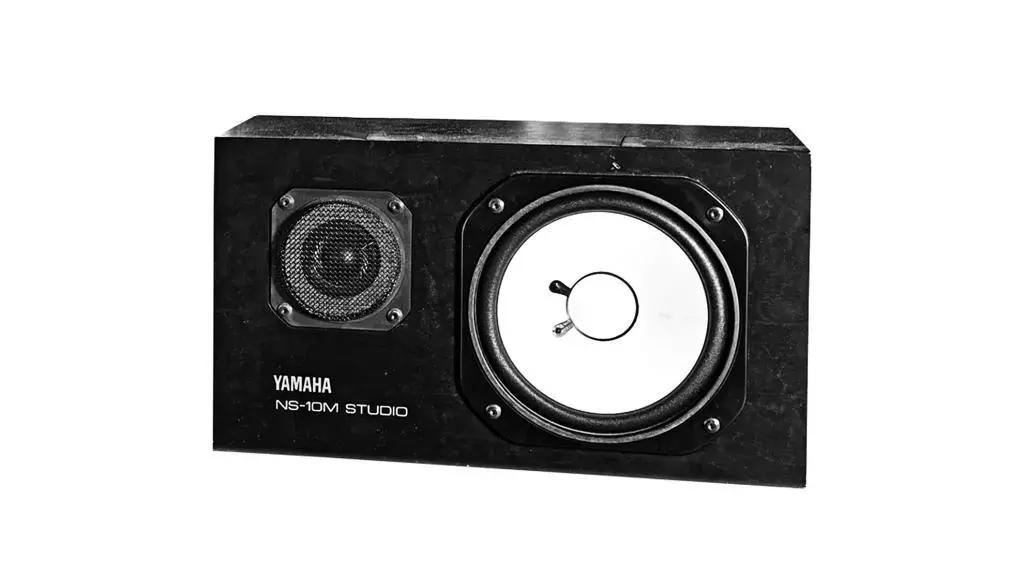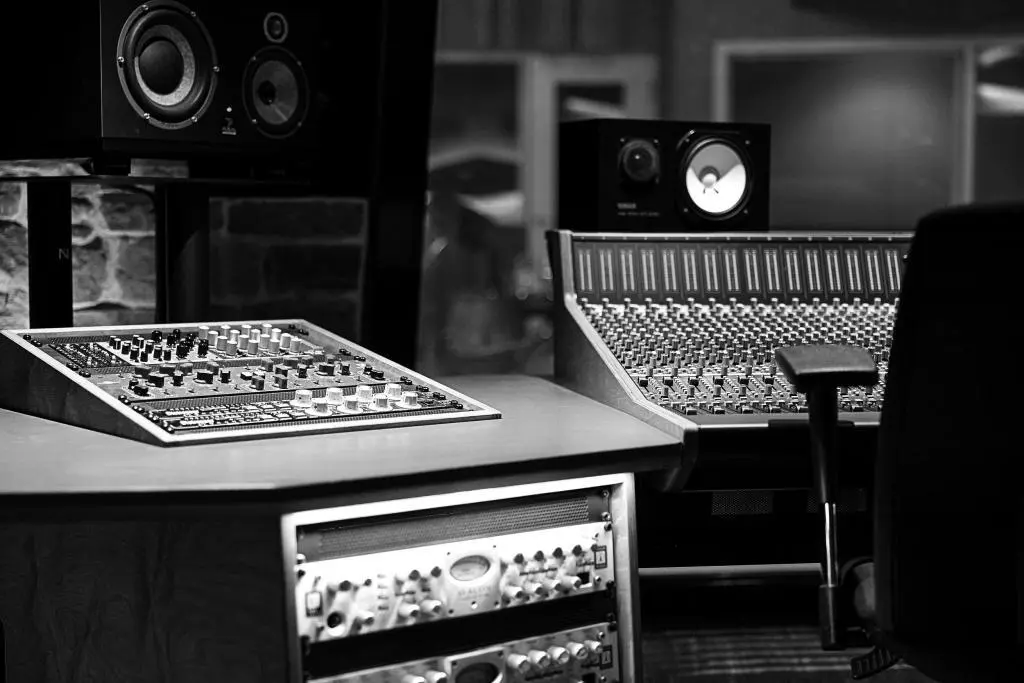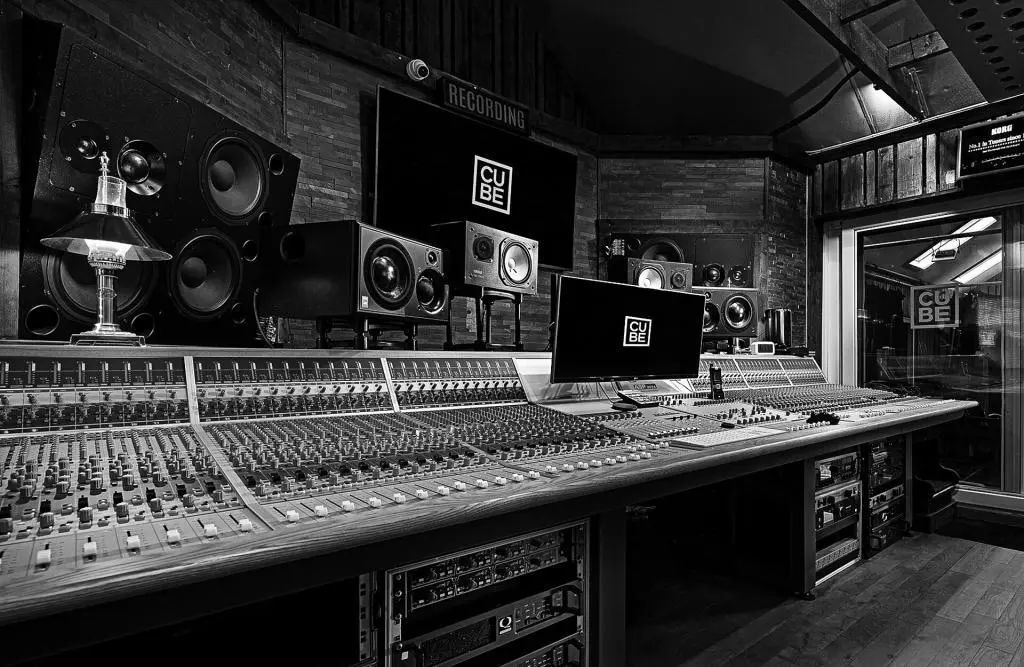In the world of music production, few pieces of studio hardware are as iconic yet enigmatic as the Yamaha NS-10 monitor speaker. With its distinctive white woofer cone and charcoal black exterior, the NS-10 is visually striking and instantly recognizable. However, the NS-10’s fascinating tale encompasses far more than mere aesthetics.
This unassuming nearfield monitor crossed over from home hi-fi obscurity into professional audio stardom – not through slick marketing or bells and whistles, but rather an almost accidental discovery of its core competence. The NS-10 could reveal the flaws in recordings like no other. Its piercingly transparent midrange laid bare all imperfections, forcing engineers to refine their mixes.
As the NS-10 proliferated throughout recording studios worldwide, so did its reputation. It became indelibly associated with the production of hit albums by the likes of Bruce Springsteen, David Bowie, and Roxy Music. Leading sound engineers like Bob Clearmountain and Rhett Davies were early adopters, solidifying the NS-10’s status.

Discover the Yamaha NS-10: Table of Contents
Despite garnering a cult following for its analytical and clinical nature, the NS-10 was not without its quirks. Attempts to tame its exaggerated highs included placing tissue paper over the tweeter – thus spawning the peculiar “tissue paper effect.”
Far from a meticulously engineered product, the NS-10’s serendipitous rise reveals just how unpredictable the path to audio innovation can be.
Its journey from living rooms to recording booths is nothing short of extraordinary. The NS-10 became the unsung hero behind countless hit records, its signature white-coned presence becoming an iconic symbol in studios worldwide. It’s not just about how it sounded, but more about what it revealed. The NS-10 had this rare quality of exposing every flaw, every imperfection in a track, pushing sound engineers to perfect their mix.
So whether you love or hate the NS-10, its story deserves to be told. For over two decades, the NS-10 stood firmly at the intersection between art and technology – helping legendary engineers analyze, critique, and craft iconic recordings. This is the definitive account of the Yamaha NS-10 phenomenon.
The NS-10 Evolution: Models Through the Decades
Every legend has its origin, its moments of triumph, evolution, and transformation. The Yamaha NS-10 is no exception. As we trace its footsteps, we’ll witness a story not just of a speaker, but of a revolution that reshaped the world of music production.
Unraveling the Timeline
1978 – Birth of the Yamaha NS-10M: More than just a home hi-fi speaker
In 1978, Yamaha released the original NS-10M nearfield monitor, designed by Akira Nakamura for home hi-fi usage. It featured an 8-inch bass/midrange driver with a distinct white cone made of pressed paper pulp. Despite its domestic aspirations, the NS-10M was quickly realized to be far more than just another bookshelf speaker.
Its revealing yet fatiguing highs and lack of low-end extension made the NS-10M poorly suited for casual listening. However, these very traits led recording engineers to recognize the speaker’s potential as an analytical mixing tool. The NS-10M soon found its way into professional studios, radically transforming perceptions of what a studio monitor could deliver.
1987 – The Studio Revolution: NS-10M Pro, Studio, and MC
By 1987, Yamaha embraced the NS-10M’s cult status among audio professionals. Capitalizing on its popularity, they released the NS-10M Pro, NS-10M Studio, and NS-10MC – revamped versions tailored specifically for critical studio use.
With a lighter and stronger sealed enclosure, reworked tweeters, upgraded crossover networks and parts, and improved power handling up to 120W, these 1980’s NS-10 models addressed many of the limitations posed by the original NS-10M. Their commercial success cemented the NS-10 as a bonafide studio monitoring standard.
1993 – The Magnetic Evolution: Introduction of NS-10MX
In 1993, Yamaha leveraged further enhancements with the NS-10MX, incorporating magnetically shielded drivers for greater placement flexibility along with a lighter yet stiffer honeycomb enclosure.
While the NS-10MX delivered incremental improvements, the core NS-10 aesthetic and sound remained largely unchanged – a testament to the original NS-10M’s technical prowess. Despite its age, musicians and engineers had grown intimately accustomed to the NS-10’s mixing capabilities.
1996 – Farewell with the NS-10MT: The bass reflex innovation
The final iteration in the storied NS-10 saga was the NS-10MT launched in 1996. Aimed at home theater usage, the NS-10MT broke new ground by adopting a bass reflex port.
This expanded the low-frequency response down to 43Hz and allowed greater positioning flexibility. While a deviation from the sealed-box design that defined earlier models, the NS-10MT’s evolution indicated Yamaha’s desire to broaden the NS-10’s appeal without diluting the intrinsic sonic qualities that made it a legend.

Diving Deep into NS-10 Technicalities
On the surface, the Yamaha NS-10 appears simple – a two-way passive monitor with a no-frills utilitarian design. However, under the hood, the NS-10 exemplified thoughtful engineering that enabled its unique mixing capabilities. The devil is in the details, and by delving into the NS-10’s core specifications across different models, we can better understand the technical elements that contributed to its legendary status.
Specifications at a Glance
When it comes to understanding the NS-10’s prowess, numbers tell a captivating story. At its core, the NS-10 boasts a unique frequency response that ensures sound clarity, making even the minutest of details audible. This isn’t just about volume; it’s about balance, ensuring that every note, every beat, and every instrument is faithfully reproduced.
The NS-10’s power dynamics are another marvel, capable of handling a range of audio without distortion. Whether it’s the gentle strumming of a guitar or the powerful beats of a drum, the NS-10 ensures that the sound remains true to its source.
And then, there’s the NS-10’s driver dimensions. Yamaha’s meticulous design ensures that the speakers are perfectly sized, allowing for optimal sound dispersion and clarity. It’s a balance of science and art, ensuring that every corner of the room gets an authentic audio experience.
Key Attributes for Yamaha NS-10
- Two-way passive crossover design
- 8 ohm nominal impedance
- Sealed enclosure for most models
- 180mm (7″) bass/midrange paper cone driver
- 35mm (1.4″) soft dome tweeter
- 2kHz crossover frequency
- Rated power handling from 25W to 120W
- Frequency response varying by model, typically 60Hz to 20kHz
- Dimensions around 380mm x 215mm x 200mm (15″ x 8.5″ x 7.9″)
Comparing NS-10 Models
While sharing common DNA, the different NS-10 models over the years also exhibited some distinctions. The following chart summarizes and contrasts the key specifications across the various NS-10 versions:
| Serie | NS-10M | NS-10M PRO | NS-10M STUDIO | NS-10MC | NS-10MX | NS-10MT |
|---|---|---|---|---|---|---|
| Year | 1978 | 1987 | 1987 | 1987 | 1993 | 1995 |
| Crossover Frequency | 2Khz (12dB/octave) | 2Khz (12dB/octave) | 2Khz (12dB/octave) | 2Khz (12dB/octave) | 2Khz (12dB/octave) | 2Khz (12dB/octave) |
| Frequency Response | 85Hz – 20Khz | 60Hz – 20Khz | 60Hz – 20Khz | 60Hz – 20Khz | 60Hz – 20Khz | 43Hz – 30Khz |
| Nominal Impedance | 8 Ohm | 9 Ohm | 8 Ohm | 8 Ohm | 8 Ohm | 6 Ohm |
| Nominal Power Input | 25W | 60W | 60W | 60W | 60W | 60W |
| Maximum Power Input | 50W | 120W | 120W | 120W | 120W | 180W |
| SPL | 90 dB | 90 dB | 90dB | 90dB | 90 dB | 90 dB |
| Dimensions | 382(H) x 215(W) x 199(D)mm | 21.5 x 38.2 x 19.9cm | 382 x 215 x 198mm | 381.5mm x 215mm x 200.5mm | 21.5 x 38.2 x 19.9cm | 215mm x 382mm x x 255mm |
| Weight | 6kg | 6kg | 6.3kg | 6.5kg | 7kg | 9kg |
| Placement | Verticle / Bookshelf | Verticle / Bookshelf | Horizontal / Bookshelf | Horizontal / Mounted | Verticle / Bookshelf | Verticle / Mounted |
The incremental yet meaningful improvements reflected Yamaha’s efforts to refine the NS-10 formula while retaining the intrinsic qualities that made it a studio staple. The chart illustrates how models like the NS-10MX and NS-10MT pushed boundaries while upholding the NS-10 legacy.
The Signature Yamaha NS-10 Sound
The Yamaha NS-10 delivered a signature sound that was immediately identifiable and unlike any other studio monitor. Let’s examine what comprised that one-of-a-kind sonic experience.
First and foremost was the NS-10’s piercingly transparent midrange reproduction. The aggressive 2-5kHz boost resulted in exceptional mid clarity that highlighted the smallest nuances and imperfections in recordings. This demanding midrange laid tracks bare, forcing engineers to refine their mixes to sound superb through the NS-10’s unforgiving focal point.
In contrast to the commanding midrange, the NS-10 exhibited a noticeable roll-off in low-end response. With a sealed cabinet, the closed-box design limited bass extension, typically cutting off around 60-85Hz depending on the specific model. However, this constraint encouraged proper bass balancing, as engineers had to work harder to achieve low-end clarity.
Additionally, the NS-10 exemplified extremely fast transient response – the ability to promptly react to changing audio signals. This transient agility gave instruments more defined attacks and realistic decay characteristics. It also contributed to precise rhythmic cohesion and tighter timing across the frequency spectrum.
Finally, the NS-10’s low distortion specs ensured purer reproduction, while its 8 ohm nominal impedance provided electrical compatibility with a variety of professional amplifiers. Together, these attributes allowed the NS-10 to transparently convey recordings without excessive coloration.

From Studios to Legends
The journey of the NS-10 is intertwined with stories of innovation, endorsement, and the relentless pursuit of acoustic perfection. Let’s journey back in time and unravel this saga.
The Clearmountain Endorsement
The Yamaha NS-10’s meteoric rise was fueled in part by the support of pioneering engineer Bob Clearmountain. In the late 1970s, Clearmountain was an emerging force who traveled from studio to studio with his own set of gear.
Seeking consistent reference monitors, he discovered the transparent analytical nature of the NS-10. Clearmountain promptly adopted the fledgling NS-10, bringing it into world-class facilities like The Power Station in New York.
His prominence as an engineer on era-defining albums massively accelerated the NS-10’s popularity. Clearmountain’s seal of approval established the NS-10 as a studio staple for commercial rock and pop records.
Rock/Pop’s Preferred Companion
Throughout the late 1970s and 1980s, the NS-10 became intrinsically linked to rock and pop production. Acts like Bruce Springsteen, David Bowie, and Roxy Music relied on the NS-10 during recording and mixing.
The speaker’s incisive midrange and transient speed lent itself perfectly to sculpting drums, bass, guitars and vocals. As hits were crafted on the NS-10, its reputation grew to mythic status. Owning NS-10s became a prerequisite for commercial studios wishing to attract big-name producers and artists.
In this golden era, the NS-10 cemented its legacy as the nearfield monitor of choice for mainstream music.
Production Insights Revealed
Beyond commercial success, the NS-10 provided unique production insights that engineers came to depend on. Its transparency illuminated problems, while its tendency to highlight harshness and muddiness forced engineers to finesse mixes with care and precision.
The NS-10 could be ruthlessly revealing, but this allowed professionals to craft recordings with confidence that translated reliably across systems. For many, manufacturing a hit was impossible without the NS-10’s burdensome yet gratifying truth.

Decoding the NS-10 Popularity Code
There’s a certain allure to the Yamaha NS-10 that transcends its technical specifications. It’s not just about how it sounds, but rather how it makes music feel. Across the globe, studios of all sizes, genres, and histories swear by the NS-10. But what is it about this studio monitor that has captivated the hearts and ears of so many?
Why the World Swears by NS-10
In a market flooded with flashy new reference monitors, the enduring devotion to the Yamaha NS-10 seems almost paradoxical. What explains its unprecedented popularity spanning decades?
Consistency Across Studios
For freelance engineers regularly transitioning between studios, the NS-10 provided sonic consistency and familiarity. As Bob Clearmountain and others championed the speaker, it organically proliferated as a reliable reference. Owning NS-10s became essential for engineers to transport their mixing skills.
Crafting Flawless Mixes
The NS-10’s sheer transparency and forensic midrange highlighted flaws no other speaker could reveal. For many, sculpting mixes that sounded balanced on the NS-10 provided assurance that technical issues were resolved. Its brutal honesty pushed engineers to polish mixes to new levels of precision.
The Consumer Speaker Benchmark
Part of the NS-10’s magic was its perceived embodiment of average consumer speakers. Despite not being designed as such, its compact size, limited bass and forward midrange were viewed as representative of domestic hi-fi systems. This meant mixes honed on the NS-10 readily translated to real-world environments. By proxy, the NS-10 gave professional engineers access to the end-listener’s perspective.
In these ways, the NS-10 earned its mythical status. It stood firmly between art and science, uniquely equipped to deliver mixes both technically flawless and creatively exceptional.
The NS-10 Sound Alchemy: “Tissue Paper Effect”
The Yamaha NS-10‘s standout midrange clarity came at a cost – an oft overbearing high frequency response. Engineers got creative at tempering these rogue treble peaks.
Innovations and Improvisations
Seeking to soften the NS-10’s sharpness, innovative engineers resorted to placing tissue paper over the tweeter. Surprisingly, this unorthodox technique gained immense popularity in the 1980s.
While duct tape and toilet paper all made cameo appearances, certain tissues imparted a smoother high-end roll-off. However, results varied wildly based on tissue fibers, density, and layered thickness.
This experimental, unpredictable process spawned the infamous NS-10 “tissue paper effect.” It epitomized the speaker’s cultural significance – professionals were willing to try almost anything to harness its mixing superpowers.
Comb Filtering Perils
In reality, the tissue paper approach was far from ideal. Beyond inconsistent damping, it introduced new issues like comb filtering and distorted frequency response.
As sound waves bounced between the tissue and tweeter, cancellation dips and ragged off-axis performance were common side effects. While tamping down brightness, tissue paper sacrificed accuracy in ways counterproductive to the NS-10’s resolving abilities.
In the end, the tissue technique highlighted the NS-10’s esteemed status. For better or worse, this speaker warranted unorthodox customization efforts simply unavailable for conventional monitors.
Yamaha’s NS-10 Curtain Call
After 23 illustrious years, Yamaha abruptly discontinued NS-10 production in 2001 – a perplexing decision given its cult status. Let’s analyze this turn of events.
Piecing Together the Puzzle
Yamaha cited material sourcing issues, specifically limited availability of the specialized paper pulp for the NS-10’s woofer cone. However, some questioned whether this was an excuse, noting ongoing surplus of spare parts.
Other theories included declining market demand and Yamaha prioritizing newer powered monitors like the MSP5. The NS-10’s unforgiving nature meant it was respected more than loved, limiting its addressable audience despite fame.
Ultimately, Yamaha’s motivations remain ambiguous. But effectively discontinuing the NS-10 at its peak popularity was likely a calculated business move rather than purely supply-chain constraints.
The NS-10 Flame Burns On
Remarkably, even 15+ years after discontinuation, the NS-10’s legacy endures. Vintage pairs in circulation keep the NS-10 on the frontlines, while replacement parts maintain existing units.
New speakers like the Avantone CLA-10 pay homage to NS-10 design cues. Yamaha itself revisited the formula with anniversary editions such as the Soavo NS-10.
Though official production has ended, the NS-10’s spirit persists through new equipment inspired by its no-frills, performance-driven ethos. The NS-10 may be gone, but its legacy remains firmly ingrained in recording studios worldwide.
Crafting the NS-10 Legacy
Over 40 years since its debut, the Yamaha NS-10 continues influencing professional studio monitor engineering and design.
Its compact footprint, passive simplicity, and transparent midrange laid the groundwork for modern nearfield monitors. Signature cues like woofer material, angled cabinets, and analog crossover circuits proliferated post-NS-10.
Today’s most esteemed studio monitors carry the NS-10 torch, melding digital precision with timeless analog character. In this sense, the NS-10 legacy persists through contemporary equipment striving for the same musical mastery.
The Grammy Nod
At the 2007 Technical Grammy awards, the Recording Academy specially recognized Yamaha for the NS-10M’s impact on the music industry.
This honor celebrated the NS-10M’s role in enabling the creative works of artists, producers and engineers over decades. The award cemented the NS-10’s status as one of the most influential and important studio monitors ever conceived.
An Old Legend in a New World
Remarkably, in today’s digital production landscape, the vintage NS-10 still finds itself at home. Its elemental, organic quality offers an anchoring counterbalance when crafting music virtually.
For purists, the NS-10’s sheer analog realism remains irresistible. Much has changed, but the NS-10 stays timeless. It embodies a monitor purity for the ages – explaining its persevering appeal to yesterday’s legends, today’s grammy winners, and tomorrow’s pioneers.

